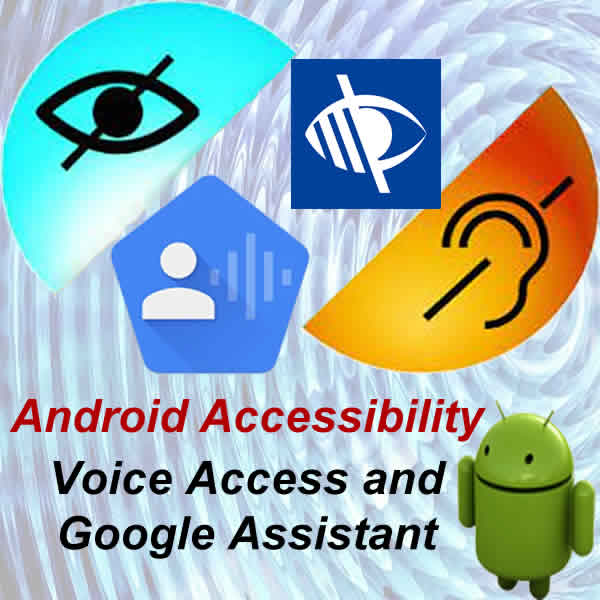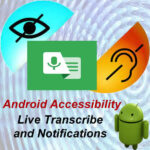Android’s Voice Commands
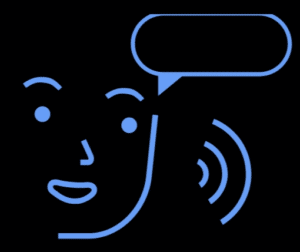
The Voice Access Spoken Commands app for Android works directly with the Google Assistant app. the Voice Access app provides uses more commands that are not recognized by Google Assistant. The Voice Access Spoken Commands app is very useful for those with limited agility with their hands to use the touch screen on Android devices. Instead of touching the screen, you speak voice commands.
This app uses the Accessibility API to assist people who have motor skills impairments. It gathers information about controls on the screen and activates them according to the voice commands given. This guide will equip you with essential commands to navigate, type, control media, and more!
Here’s what you can expect from using Android’s Voice Commands:
- Effortlessly navigate your phone: Open apps, access settings, and even switch between screens using simple voice commands.
- Type without touching the keyboard: Dictate text messages, emails, and notes with ease.
- Control your media: Play, pause, skip tracks, and adjust volume without lifting a finger. [Image depicting a person using voice commands on their Android phone to type a text message]
- Discover advanced features: Explore gestures, custom commands, and accessibility options for a personalized experience. [Image showcasing the Voice Access grid with various commands and options]
Embrace the world of hands-free control! Start unlocking the full potential of your Android device with Voice Access.
How to install Voice Access with Spoken Commands?
For help installing apps – How to install Apps on Android?.
Requirements:
- All the apps must be using the same language, Android phone, Google Assistant and Voice Access
- You should have a newer Android device, with Android version 11 or more, to be able to use all the features and functions of the Accessibility apps.
- Be sure you have the latest Google App version installed. Download or upgrade Google App – Download Google app
- Google Assistant must be installed, enabled and responding to the “Hey Google” voice command. How to use Google Assistant on Android?
Go to Google Play store and download Voice Access – Download Voice Access app.
How to use Android Voice Commands?
- Open Settings and scroll down then Touch on Accessibility
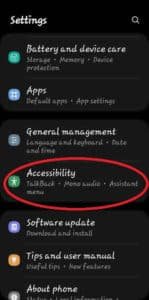
- Scroll down and Touch on Installed Apps
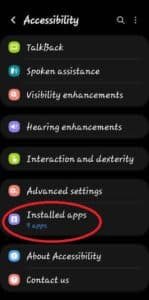
- Scroll down and Touch on Voice Access
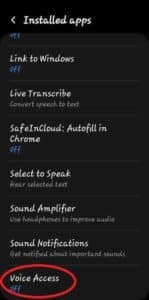
- Move the top slider button to the right to turn on Voice Access
- Enable the Voice Access shortcut – this is a must have option to easily turn Voice Access on or off.
- Decide how you want to use the shortcut to enable Voice Access
- The recommended method is to use the Accessibility Button, enable that option.
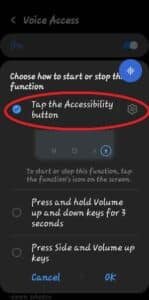
- When you first turn on Voice Access, you will be given the option to set up Voice Access
- Enable the Start Listening Button – this is a floater button that is always on the screen over everything else. You can easily turn Voice Access on and off using the floater button.
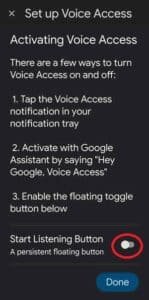
You can use these Android Voice Commands on any screen:
The following is from the Google published documentation for using voice commends.
General commands:
- Open [app]
- Go back
- Go home
- Show notifications
- Show Quick Settings
- Show recent apps
- If you receive a call, you can answer it by saying “Answer call.”
Voice Access help:
- What can I say?
- Show all commands
- Open tutorial
- Show numbers
- Hide numbers
- Show labels
- Hide labels
- What is [number]?
- Stop Voice Access
- Send feedback
Settings:
- Turn on Bluetooth
- Turn off Bluetooth
- Turn up volume
- Turn down volume
- Turn [media/alarm/phone] volume up
- Turn [media/alarm/phone] volume down
- Mute
- Silence
- Unmute
- Mute [media/alarm/phone] volume
- Unmute [media/alarm/phone] volume
- Turn device off
Assistant:
You can speak commands to the Google Assistant, such as:
- Hey Google, set timer for [amount of time]
- Hey Google, turn on flashlight
- Hey Google, when was the Empire State Building built?
- Hey Google, who created Google?
Typing and Editing:
- “Type [text]”
- “Select [text]”
- “Delete [text]”
- “Correct [word]”
- “Capitalize [letter]”
Media playback:
- “Play music”
- “Pause/resume”
- “Skip track”
- “Adjust volume”
Additional features:
- “Show numbers” (activates the on-screen grid for precise control)
- “Custom commands” (create personalized shortcuts)
- “Accessibility settings” (fine-tune the app to your specific needs)
Voice Access numbers:
To show an overlay of numbers next to everything on your screen that you can interact with, say “Show numbers.” If you don’t know the name for something, say “Show labels” to see suggestions.
For example, you might see the number 7 next to a Save button, like this: . To select the Save button, you could say any of these commands:
- 7
- Save
- Tap 7
- Tap Save
If two items on your screen have the same text label (such as two “Options” menus), you can say the number instead of the word. Also, if a text label is long or difficult to pronounce, saying the number might be easier.
If you’re not sure which item on your screen goes with a number, you can say “What is [number]?” For example, “What is 7?”
Frequently Asked Questions (FAQ) about Android Voice Commands:
1. What is Voice Access?
Voice Access is a built-in Android accessibility feature that allows you to control your device using spoken commands and gestures. It’s a powerful tool for people who have difficulty using the touchscreen, such as those with disabilities or injuries.
2. How does Voice Access work?
Voice Access uses your device’s microphone and speech recognition software to translate your spoken words into commands. You can use simple commands like “Open [app name]” or “Go home”, as well as more advanced commands like “Scroll down” or “Select text”.
3. What are some of the benefits of using Voice Access?
There are many benefits to using Voice Access, including:
- Increased accessibility: Voice Access makes your Android device more accessible to people with disabilities or injuries.
- Hands-free control: You can control your device without lifting a finger, which is ideal for driving, cooking, or other activities where you need your hands free.
- Improved productivity: Voice Access can help you work faster and more efficiently by allowing you to dictate text and control your device hands-free.
- Reduced fatigue: Using Voice Access can help to reduce fatigue from using your touchscreen for extended periods of time.
4. How do I use Voice Access?
To use Voice Access, you need to turn it on in your Android settings. Once it is activated, you can start using it by saying “OK Google, start Voice Access”.
5. What are some essential Voice Access commands?
Some essential Voice Access commands include:
- Navigation: “Go home”, “Open [app name]”, “Go back”, “Scroll up/down”, “Swipe left/right”
- Typing and Editing: “Type [text]”, “Select [text]”, “Delete [text]”, “Correct [word]”, “Capitalize [letter]”
- Media playback: “Play music”, “Pause/resume”, “Skip track”, “Adjust volume”
- Additional features: “Show numbers”, “Custom commands”, “Accessibility settings”
6. What are some troubleshooting tips for Voice Access?
If you are having trouble with Voice Access, there are a few things you can try:
- Make sure your device is connected to the internet.
- Move to a quiet place with little background noise.
- Speak clearly and slowly.
- Use the recommended microphone settings.
- Restart your device.
- Check for updates to the Voice Access app.
If you are still having trouble, you can contact Google support for assistance.
7. What are some alternative voice control apps?
There are a number of alternative voice control apps available for Android, such as:
- Dragon Anywhere: A powerful dictation app with advanced features.
- My Voice: A simple and easy-to-use voice control app.
- Voice Control Pro: A fully customizable voice control app with support for multiple languages.
8. What is the future of Voice Access?
Voice Access is constantly being updated and improved by Google. In the future, we can expect to see even more features and capabilities added to the app, making it even more powerful and versatile.
9. What are the limitations of Voice Access?
While Voice Access is a powerful tool, it does have some limitations. For example, it can sometimes be difficult to use in noisy environments or if you have a strong accent. Additionally, Voice Access may not be able to control all aspects of your device, such as certain custom apps or features.
Description |
Accessibility Page Links |
| Android’s sound amplifier for the hard of hearing or hearing impaired | Sound Amplifier for the Hard of Hearing – Android |
| Use the voice access module to speak commands to Android | Voice Access Spoken Commands – Android |
| Magnify the text and images on the screen for users with low vision and visually impaired | Screen Magnification for Low Vision – Android |
| TalkBack screen reader to tell you about your actions for the blind and visually impaired | TalkBack Screen Reader for Android |
| TalkBack braille keyboard for your Android device | Talkback Braille Keyboard for Android |
| Change the font and image size displayed on all screens for the partially blind and visually impaired | Change Font and Image Size for Partially blind – Android |
| Google’s Live Transcribe and Notification app is very useful speech-to-text tool | Google Live Transcribe and Notification for Android |
